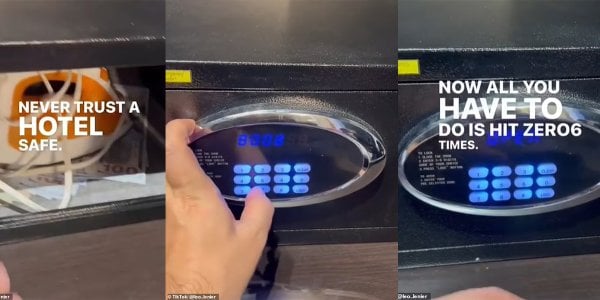This savvy traveller cracked open hotel safes without the code: ‘I’m not leaving the house’
When we’re on a holiday, our safety becomes a top concern.
That’s why many of us choose hotels that offer in-room safes to protect our valuables. This allows us to check in and enjoy our activities without security concerns.
However, it was recently discovered that this is not always the case, as this person was able to crack one safe even without a code!
A traveller drew attention by sharing a video revealing why the safest spot in a hotel room may not be as secure as you think.
A man named Leo Lenier highlighted a potential weakness in hotel safes by demonstrating how easily they can be unlocked and reset.
Leo, who is from Las Vegas, started the video by advising viewers to ‘never trust a hotel safe’.
‘You think that by locking it in a safe and making up your own combination, it’ll be safe,’ he said while inputting his code.
'It says it's locked, it says it's safe,' he continued, shaking the door to show it was securely locked.
Leo then proceeded to show how to unlock the safe and reset the code on the door—even without knowing the original code.
First, he pressed the ‘lock’ button twice, and the word ‘super’ appeared on the screen.
‘Now all you have to do is hit “zero” six times, and it opens up,’ he said, as the door of the safe swung wide open, revealing the contents.
‘That doesn’t seem very safe,’ Leo concluded.
Other social media users were amazed by the clip, which has garnered over 1.5 million views since posting.
Many commented, with one saying, ‘I bring my own safe when I go on [holiday].’
‘It's less safe now you have announced it,’ wrote another.
‘Thanks for telling the world!’ a third shared.
Some suggested it could be safe-specific, adding: ‘I just tried it in my hotel and it doesn't work, might only be that model.’
Leo is not the only individual providing online safety tips. Earlier this year, a traveller who goes by ‘Victoria’s Way’ shared some hotel safety suggestions.
Victoria’s initial advice included using the ‘do not disturb’ sign and locking the door, which are standard safety tips.
She also suggested ‘closing the peephole’ demonstrated by inserting a small white object.
Another tip involved ‘placing a washcloth in the deadbolt loop to close the gap’, effectively preventing easy access.
She also proposed ‘blocking the door with an ironing board’ and ‘rolling up a medium-sized towel to secure the handle’.
Lastly, Victoria advised to ‘connect the handle and the deadbolt with a clothes hanger for added safety’.
However, viewer opinions were divided on the necessity of these safety measures.
One person asked, ‘Where would you need all of this?’ and another commented, ‘If I’m that worried, I’m staying home.’
Video source: TikTok/@leo…lenier

Members, what do you do with your valuables when you're checking in at hotels? Do you have additional safety tips apart from using the safe? Let us know in the comments below!
That’s why many of us choose hotels that offer in-room safes to protect our valuables. This allows us to check in and enjoy our activities without security concerns.
However, it was recently discovered that this is not always the case, as this person was able to crack one safe even without a code!
A traveller drew attention by sharing a video revealing why the safest spot in a hotel room may not be as secure as you think.
A man named Leo Lenier highlighted a potential weakness in hotel safes by demonstrating how easily they can be unlocked and reset.
Leo, who is from Las Vegas, started the video by advising viewers to ‘never trust a hotel safe’.
‘You think that by locking it in a safe and making up your own combination, it’ll be safe,’ he said while inputting his code.
'It says it's locked, it says it's safe,' he continued, shaking the door to show it was securely locked.
Leo then proceeded to show how to unlock the safe and reset the code on the door—even without knowing the original code.
First, he pressed the ‘lock’ button twice, and the word ‘super’ appeared on the screen.
‘Now all you have to do is hit “zero” six times, and it opens up,’ he said, as the door of the safe swung wide open, revealing the contents.
‘That doesn’t seem very safe,’ Leo concluded.
Other social media users were amazed by the clip, which has garnered over 1.5 million views since posting.
Many commented, with one saying, ‘I bring my own safe when I go on [holiday].’
‘It's less safe now you have announced it,’ wrote another.
‘Thanks for telling the world!’ a third shared.
Some suggested it could be safe-specific, adding: ‘I just tried it in my hotel and it doesn't work, might only be that model.’
Leo is not the only individual providing online safety tips. Earlier this year, a traveller who goes by ‘Victoria’s Way’ shared some hotel safety suggestions.
Victoria’s initial advice included using the ‘do not disturb’ sign and locking the door, which are standard safety tips.
She also suggested ‘closing the peephole’ demonstrated by inserting a small white object.
Another tip involved ‘placing a washcloth in the deadbolt loop to close the gap’, effectively preventing easy access.
She also proposed ‘blocking the door with an ironing board’ and ‘rolling up a medium-sized towel to secure the handle’.
Lastly, Victoria advised to ‘connect the handle and the deadbolt with a clothes hanger for added safety’.
However, viewer opinions were divided on the necessity of these safety measures.
One person asked, ‘Where would you need all of this?’ and another commented, ‘If I’m that worried, I’m staying home.’
Video source: TikTok/@leo…lenier
Key Takeaways
- A savvy traveller has become ‘famous’ after sharing a video demonstrating how he unlocked a hotel safe without knowing the code.
- In the video, Las Vegas-based social media user Leo Lenier managed to open a locked hotel safe in under 30 seconds by pressing ‘lock’ twice and then pressing ‘zero’ six times.
- Lenier’s video has stunned social media users and has been viewed over 1.5 million times since being posted.
- Some viewers were critical of Lenier for publicising the trick, while others suggested the method might only work on specific models of hotel safety.








